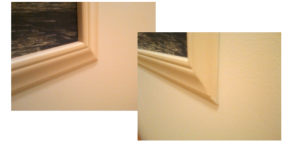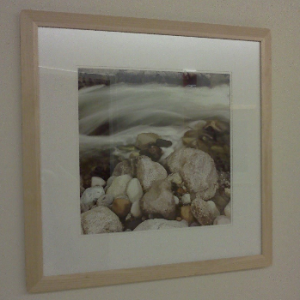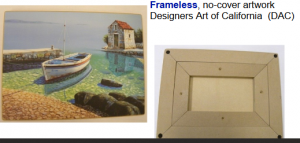Artwork For Behavioral Health
Artwork provides a visually pleasing environment but may also integrate products that cause a safety concern. All artwork and frames should be free from materials that can be broken to produce sharp edges. Likewise, artwork must be well secured to the wall to prohibit removal and consideration should be given to seal all sides and edges.
In all cases, the installation method is just as important as the type of product being provided. Installation must be supervised by an individual with the knowledge regarding the strict safety precautions necessary, and every piece should be inspected individually before the space is used for patient occupancy.
Location of the artwork should also be considered. Wall spaces within a direct line-of-sight from staff is ideal. Avoid placing artwork in alcoves or around corners from the nurse station. These spaces would allow patients an opportunity to tamper with the artwork.
Direct application:
Images can be applied directly to the wall with vinyl wall covering or painted materials. To secure edges, composite molding can be mounted directly to the wall to create a frame. All edges should be sealed to decrease tampering.
Direct application:
Pros:
Flexible material
Frame can be made from various materials
Cons:
Difficult to repair or change images
Requires routine inspection for damaged or loose items.
Adhesive Text:
Positive phrases added to walls can inspire Veterans and provide encouragement toward recovery. Adhesive text should be mounted in locations where it can be seen but not accessed. Additionally, consider an application of a clear finish topcoat to protect the text and secure edges.
Adhesive Text:
Pros:
Flexible material
Applied directly to the walls with no depth or framing needs
Cons:
Difficult to repair or change text
Requires routine inspection for loose edges.
Security Frame Artwork:
Security frame artwork is comprised of multiple components. The artwork itself is matted and secured to the outer frame and covered with a non-breakable Lexan material. An additional component (or interior frame) fits inside the outer frame and is completely concealed when fully installed. The entire piece should then be sealed to the wall with a clear caulking.
Not only is the framing and physical composition of the artwork important, but careful consideration should be given to the images within the artwork as well. Specific colors or images may impact the recovery of the patients. Speak with the staff to gain information on the specific population of the Veterans at your facility and geographic area.
Security Frame Designers Art of California (DAC) is working to patent this item and the installation method. For more specific information, please contact Designers Art of California.
Security Frame Artwork (DAC):
Pros:
Frame is angled and the flat top is minimal
Artwork is protected by acrylic
Appearance is similar to art-work throughout the rest
of the medical center with image and matting and frame
Cons:
Requires routine inspection for damage or signs of tampering.
Printed Acrylic:
Printed Acrylic provides artwork without unnecessary layers of material or framing. The image is printed on the back of clear acrylic with beveled edges and secured with counter-sunk tamper-resistant screws. Edges are sealed to the wall with clear caulk. The acrylic can be specified in a gloss or matte surface.
Printed Acrylic:
Pros:
No frames or layers to separate
Artwork is protected by acrylic
No sharp edges
Matte or gloss finish
Cons:
Requires routine inspection for damage or signs of tampering
For a pdf version click here: Photos for Healing Newsletter #130- May ’19




